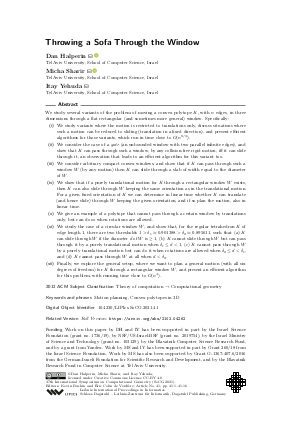LIPIcs.SoCG.2021.41.pdf
- Filesize: 1.44 MB
- 16 pages

 Creative Commons Attribution 4.0 International license
Creative Commons Attribution 4.0 International license

We study several variants of the problem of moving a convex polytope K, with n edges, in three dimensions through a flat rectangular (and sometimes more general) window. Specifically:
ii) We study variants where the motion is restricted to translations only, discuss situations where such a motion can be reduced to sliding (translation in a fixed direction), and present efficient algorithms for those variants, which run in time close to O(n^{8/3}).
iii) We consider the case of a gate (an unbounded window with two parallel infinite edges), and show that K can pass through such a window, by any collision-free rigid motion, iff it can slide through it, an observation that leads to an efficient algorithm for this variant too.
iv) We consider arbitrary compact convex windows, and show that if K can pass through such a window W (by any motion) then K can slide through a slab of width equal to the diameter of W.
v) We show that if a purely translational motion for K through a rectangular window W exists, then K can also slide through W keeping the same orientation as in the translational motion. For a given fixed orientation of K we can determine in linear time whether K can translate (and hence slide) through W keeping the given orientation, and if so plan the motion, also in linear time.
vi) We give an example of a polytope that cannot pass through a certain window by translations only, but can do so when rotations are allowed.
vii) We study the case of a circular window W, and show that, for the regular tetrahedron K of edge length 1, there are two thresholds 1 > δ₁≈ 0.901388 > δ₂≈ 0.895611, such that (a) K can slide through W if the diameter d of W is ≥ 1, (b) K cannot slide through W but can pass through it by a purely translational motion when δ₁ ≤ d < 1, (c) K cannot pass through W by a purely translational motion but can do it when rotations are allowed when δ₂ ≤ d < δ₁, and (d) K cannot pass through W at all when d < δ₂.
viii) Finally, we explore the general setup, where we want to plan a general motion (with all six degrees of freedom) for K through a rectangular window W, and present an efficient algorithm for this problem, with running time close to O(n⁴).






















Feedback for Dagstuhl Publishing